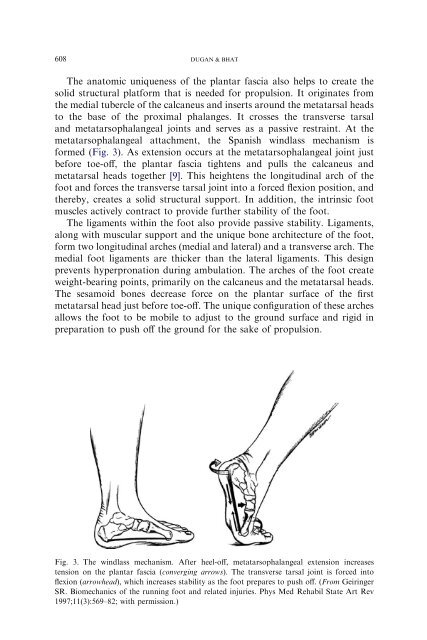Biomechanics and Analysis of Running Gait
Analysis of running
Analysis of running
Create successful ePaper yourself
Turn your PDF publications into a flip-book with our unique Google optimized e-Paper software.
608 DUGAN & BHATThe anatomic uniqueness <strong>of</strong> the plantar fascia also helps to create thesolid structural platform that is needed for propulsion. It originates fromthe medial tubercle <strong>of</strong> the calcaneus <strong>and</strong> inserts around the metatarsal headsto the base <strong>of</strong> the proximal phalanges. It crosses the transverse tarsal<strong>and</strong> metatarsophalangeal joints <strong>and</strong> serves as a passive restraint. At themetatarsophalangeal attachment, the Spanish windlass mechanism isformed (Fig. 3). As extension occurs at the metatarsophalangeal joint justbefore toe-<strong>of</strong>f, the plantar fascia tightens <strong>and</strong> pulls the calcaneus <strong>and</strong>metatarsal heads together [9]. This heightens the longitudinal arch <strong>of</strong> thefoot <strong>and</strong> forces the transverse tarsal joint into a forced flexion position, <strong>and</strong>thereby, creates a solid structural support. In addition, the intrinsic footmuscles actively contract to provide further stability <strong>of</strong> the foot.The ligaments within the foot also provide passive stability. Ligaments,along with muscular support <strong>and</strong> the unique bone architecture <strong>of</strong> the foot,form two longitudinal arches (medial <strong>and</strong> lateral) <strong>and</strong> a transverse arch. Themedial foot ligaments are thicker than the lateral ligaments. This designprevents hyperpronation during ambulation. The arches <strong>of</strong> the foot createweight-bearing points, primarily on the calcaneus <strong>and</strong> the metatarsal heads.The sesamoid bones decrease force on the plantar surface <strong>of</strong> the firstmetatarsal head just before toe-<strong>of</strong>f. The unique configuration <strong>of</strong> these archesallows the foot to be mobile to adjust to the ground surface <strong>and</strong> rigid inpreparation to push <strong>of</strong>f the ground for the sake <strong>of</strong> propulsion.Fig. 3. The windlass mechanism. After heel-<strong>of</strong>f, metatarsophalangeal extension increasestension on the plantar fascia (converging arrows). The transverse tarsal joint is forced int<strong>of</strong>lexion (arrowhead), which increases stability as the foot prepares to push <strong>of</strong>f. (From GeiringerSR. <strong>Biomechanics</strong> <strong>of</strong> the running foot <strong>and</strong> related injuries. Phys Med Rehabil State Art Rev1997;11(3):569–82; with permission.)


